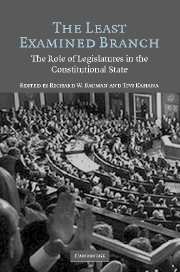Book contents
- Frontmatter
- Contents
- Foreword: Legislatures in the Constitutional State by Amy Gutmann
- Contributors
- New Ways of Looking at Old Institutions
- PART ONE LEGISLATURES AND DEMOCRATIC THEORY
- PART TWO LEGISLATING AND DELIBERATING IN THE DEMOCRATIC LEGISLATURE
- PART THREE CONSTITUTION MAKING BY LEGISLATURES: THE EXPLICIT VERSION
- PART FOUR CONSTITUTION MAKING BY LEGISLATURES: THE IMPLICIT VERSION
- PART FIVE CONSTITUTIONAL INTERPRETATION AND APPLICATION BY THE LEGISLATURE
- 16 Interpretation in Legislatures and Courts: Incentives and Institutional Design
- 17 Constitutional Engagement “Outside the Courts” (and “Inside the Legislature”): Reflections on Professional Expertise and the Ability to Engage in Constitutional Interpretation
- 18 Legislatures as Constitutional Interpretation: Another Dialogue
- 19 The Constitution and Congressional Committees: 1971–2000
- PART SIX IS LEGISLATIVE CONSTITUTIONALISM POSSIBLE?
- PART SEVEN THE LEGISLATURE IN DIALOGUE: DOMESTIC AND INTERNATIONAL CONTEXTS
- Index
18 - Legislatures as Constitutional Interpretation: Another Dialogue
Published online by Cambridge University Press: 06 August 2009
- Frontmatter
- Contents
- Foreword: Legislatures in the Constitutional State by Amy Gutmann
- Contributors
- New Ways of Looking at Old Institutions
- PART ONE LEGISLATURES AND DEMOCRATIC THEORY
- PART TWO LEGISLATING AND DELIBERATING IN THE DEMOCRATIC LEGISLATURE
- PART THREE CONSTITUTION MAKING BY LEGISLATURES: THE EXPLICIT VERSION
- PART FOUR CONSTITUTION MAKING BY LEGISLATURES: THE IMPLICIT VERSION
- PART FIVE CONSTITUTIONAL INTERPRETATION AND APPLICATION BY THE LEGISLATURE
- 16 Interpretation in Legislatures and Courts: Incentives and Institutional Design
- 17 Constitutional Engagement “Outside the Courts” (and “Inside the Legislature”): Reflections on Professional Expertise and the Ability to Engage in Constitutional Interpretation
- 18 Legislatures as Constitutional Interpretation: Another Dialogue
- 19 The Constitution and Congressional Committees: 1971–2000
- PART SIX IS LEGISLATIVE CONSTITUTIONALISM POSSIBLE?
- PART SEVEN THE LEGISLATURE IN DIALOGUE: DOMESTIC AND INTERNATIONAL CONTEXTS
- Index
Summary
I am especially grateful for this occasion to discuss the much overlooked role of the legislatures in the interpretation of the Canadian Constitution. Indeed, courts are seen as the main – if not the only – interpreters of the Constitution, and often criticized for what is seen as expanding their role into “lawmaking” at the expense of legislatures. However, the balance between the two institutions is more subtle and it is in that quite intricate web of interrelations that constitutional interpretation must be understood. I begin by briefly debunking a prevalent myth by showing both that the interpretive role of the courts has not increased as much as many claim since the entrenchment of the Charter, and that such a role is not now or ever has been exercised in a totally discretionary manner. I will then put the role of the legislatures in proper theoretical perspective by showing that far from only having the last word through the notwithstanding clause, they always have the first and most often the only word in a scenario where their interpretation prevails in the vast majority of instances, as they engage democratically in an altogether different dialogue than the institutional one.
DEBUNKING A MYTH
It is widely held, not only in the general public but unfortunately also in parts of the legal community, that the courts, and especially the Supreme Court of Canada, have dramatically increased and changed their role and their relationship to legislatures since the entrenchment of the Charter in 1982.
- Type
- Chapter
- Information
- The Least Examined BranchThe Role of Legislatures in the Constitutional State, pp. 385 - 395Publisher: Cambridge University PressPrint publication year: 2006
- 1
- Cited by



